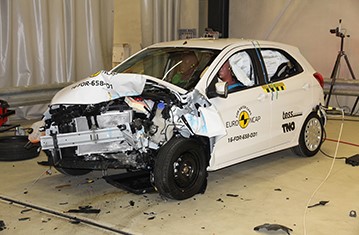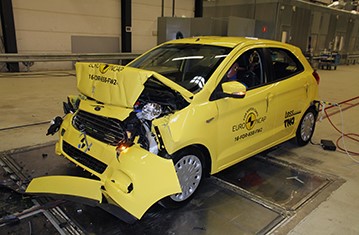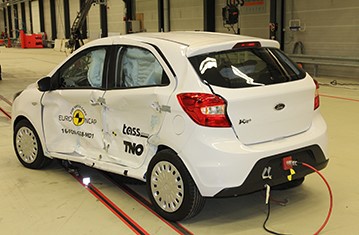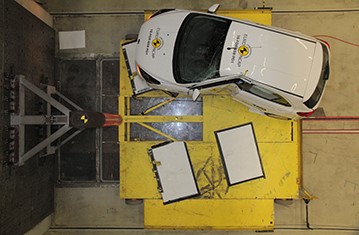- With standard equipment
- With safety pack
Find more information in the General Comments section of the assessment
Find more information in the Rating Validity tab of the assessment
- See More
- See More
- See More
- See More
- Good
- Adequate
- Marginal
- Weak
- Poor
 Passenger
Passenger
 Driver
Driver
 Rear Passenger
Rear Passenger
 Driver
Driver
 Car
Car
 Pole
Pole
 Rear Seat
Rear Seat
 Front Seat
Front Seat
- Good
- Adequate
- Marginal
- Weak
- Poor


Passenger
outboard
center
Fitted to the vehicle as standard
Not fitted to the test vehicle but available as option
Not Available
-
i-Size CRS
-
ISOFIX CRS
-
Universal Belted CRS
Easy
Difficult
Safety critical
Not allowed
| Seat Position | ||||
|---|---|---|---|---|
| Front | 2nd row | |||
| Passenger | Left | center | Right | |
| Maxi Cosi 2way Pearl & 2wayFix (rearward) (iSize) | ||||
| Maxi Cosi 2way Pearl & 2wayFix (forward) (iSize) | ||||
| BeSafe iZi Kid X2 i-Size (iSize) | ||||
| Maxi Cosi Cabriofix & FamilyFix (ISOFIX) | ||||
| BeSafe iZi Kid X4 ISOfix (ISOFIX) | ||||
| Britax Römer Duo Plus (ISOFIX) | ||||
| Britax Römer KidFix XP (ISOFIX) | ||||
| Maxi Cosi Cabriofix (Belt) | ||||
| Maxi Cosi Cabriofix & EasyBase2 (Belt) | ||||
| Britax Römer King II LS (Belt) | ||||
| Britax Römer KidFix XP (Belt) | ||||
Easy
Difficult
Safety critical
Not allowed
In the frontal offset test, readings from the 6 year dummy indicated good head protection, marginal chest protection and a weak level of protection for the neck. The 10 year dummy also showed weak protection of the neck. Dummy readings indicated good protection of the chest and head but the score was penalised owing to the diagonal part of the seatbelt slipping off the dummy's shoulder in the test. In the side barrier test, protection of all critical body areas was good and the Ka+ scored maximum points. The front passenger airbag can be disabled to allow a rearward-facing child restraint to be used in that seating position. Clear information is provided to the driver regarding the status of the airbag and the system was rewarded. Child restraints could not be properly installed in the rear centre seating position and the iSize anchorages could not be easily engaged for one restraint in the rear outboard seats.
- Good
- Adequate
- Marginal
- Weak
- Poor

Head Impact 15.8 Pts
Pelvis Impact 2.5 Pts
Leg Impact 6.0 Pts
The bonnet provided predominantly good or adequate protection to the head of a struck pedestrian, with poor results recorded on the front edge of the windscreen and on the stiff windscreen pillars. The bumper scored maximum points for its protection of pedestrians' legs with good results at all test points. Protection of the pelvis was mixed, with good and poor results.
- Good
- Adequate
- Marginal
- Weak
- Poor
| System Name | Speed Limiter |
| Warning Function | Manually set |
| Speed Limitation Function | Manually set (accurate to 5km/h) |
| Applies To | Front seats | ||
| Warning | Driver Seat | Front Passenger(s) | Rear Passenger(s) |
| Visual | |||
| Audible | |||
|
|||
The Ka+ has a seatbelt reminder system for the front seats only, and a standard-fit driver-set speed limitation device. Neither autonomous emergency braking nor lane assistance is available.
- Specifications
- Safety Equipment
- Videos
- Rating Validity
Specifications
Tested Model Ford Ka+ 1.2, LHD
Body Type - 5 door hatchback
Year Of Publication 2017
Kerb Weight 1059kg
VIN From Which Rating Applies - all Ka+
Class City and Supermini
Safety Equipment
Note: Other equipment may be available on the vehicle but was not considered in the test year.
Fitted to the vehicle as standard
Fitted to the vehicle as part of the safety pack
Not fitted to the test vehicle but available as option or as part of the safety pack
Not available
Not applicable
Videos
Rating Validity
Variants of Model Range
| Body Type | Engine & Transmission | Drivetrain | Rating Applies | |
|---|---|---|---|---|
| LHD | RHD | |||
| 5 door hatchback* | 1.2 Manual | 4x2 (FWD) |
 |
 |
* Tested variant

Find more information in the General Comments section of the assessment
 Share
Share











The passenger compartment of the Ka+ remained stable in the frontal offset test. Dummy readings showed good protection of the knees and femurs of both the driver and passenger. However, structures in the dashboard were thought likely to pose a risk to occupants of different sizes and to those sat in different positions and the score was penalised. Dummy readings of chest compression indicated a marginal level of protection for this part of the body for both the driver and passenger. In the full-width rigid barrier test, protection of the driver was good for all areas apart from the chest, protection of which was adequate. However, measurement of compression indicated poor protection for the chest of the rear passenger dummy and head decelerations demonstrated weak head protection. In contrast, the Ka+ scored maximum points in both the side barrier test and the more severe side pole impact, with good protection of all critical body areas. Tests on the front seats and head restraints demonstrated good protection against whiplash injuries in the event of a rear-end collision. A geometric assessment of the rear seats indicated a marginal level of whiplash protection. The Ka+ does not have an autonomous emergency braking system.